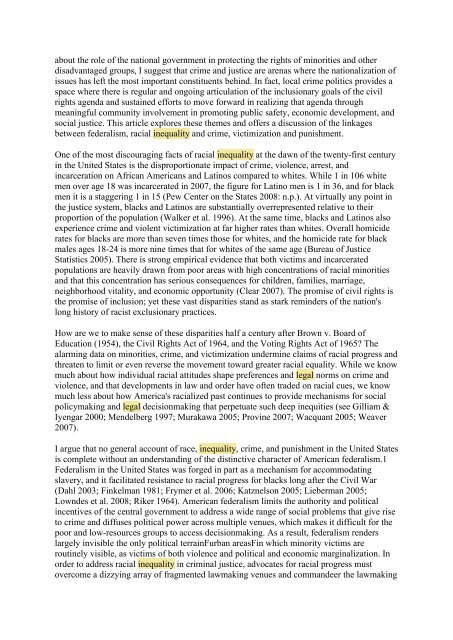The Invisible Black Victim: How American Federalism Perpetuates ...
The Invisible Black Victim: How American Federalism Perpetuates ...
The Invisible Black Victim: How American Federalism Perpetuates ...
You also want an ePaper? Increase the reach of your titles
YUMPU automatically turns print PDFs into web optimized ePapers that Google loves.
about the role of the national government in protecting the rights of minorities and other<br />
disadvantaged groups, I suggest that crime and justice are arenas where the nationalization of<br />
issues has left the most important constituents behind. In fact, local crime politics provides a<br />
space where there is regular and ongoing articulation of the inclusionary goals of the civil<br />
rights agenda and sustained efforts to move forward in realizing that agenda through<br />
meaningful community involvement in promoting public safety, economic development, and<br />
social justice. This article explores these themes and offers a discussion of the linkages<br />
between federalism, racial inequality and crime, victimization and punishment.<br />
One of the most discouraging facts of racial inequality at the dawn of the twenty-first century<br />
in the United States is the disproportionate impact of crime, violence, arrest, and<br />
incarceration on African <strong>American</strong>s and Latinos compared to whites. While 1 in 106 white<br />
men over age 18 was incarcerated in 2007, the figure for Latino men is 1 in 36, and for black<br />
men it is a staggering 1 in 15 (Pew Center on the States 2008: n.p.). At virtually any point in<br />
the justice system, blacks and Latinos are substantially overrepresented relative to their<br />
proportion of the population (Walker et al. 1996). At the same time, blacks and Latinos also<br />
experience crime and violent victimization at far higher rates than whites. Overall homicide<br />
rates for blacks are more than seven times those for whites, and the homicide rate for black<br />
males ages 18-24 is more nine times that for whites of the same age (Bureau of Justice<br />
Statistics 2005). <strong>The</strong>re is strong empirical evidence that both victims and incarcerated<br />
populations are heavily drawn from poor areas with high concentrations of racial minorities<br />
and that this concentration has serious consequences for children, families, marriage,<br />
neighborhood vitality, and economic opportunity (Clear 2007). <strong>The</strong> promise of civil rights is<br />
the promise of inclusion; yet these vast disparities stand as stark reminders of the nation's<br />
long history of racist exclusionary practices.<br />
<strong>How</strong> are we to make sense of these disparities half a century after Brown v. Board of<br />
Education (1954), the Civil Rights Act of 1964, and the Voting Rights Act of 1965? <strong>The</strong><br />
alarming data on minorities, crime, and victimization undermine claims of racial progress and<br />
threaten to limit or even reverse the movement toward greater racial equality. While we know<br />
much about how individual racial attitudes shape preferences and legal norms on crime and<br />
violence, and that developments in law and order have often traded on racial cues, we know<br />
much less about how America's racialized past continues to provide mechanisms for social<br />
policymaking and legal decisionmaking that perpetuate such deep inequities (see Gilliam &<br />
Iyengar 2000; Mendelberg 1997; Murakawa 2005; Provine 2007; Wacquant 2005; Weaver<br />
2007).<br />
I argue that no general account of race, inequality, crime, and punishment in the United States<br />
is complete without an understanding of the distinctive character of <strong>American</strong> federalism.1<br />
<strong>Federalism</strong> in the United States was forged in part as a mechanism for accommodating<br />
slavery, and it facilitated resistance to racial progress for blacks long after the Civil War<br />
(Dahl 2003; Finkelman 1981; Frymer et al. 2006; Katznelson 2005; Lieberman 2005;<br />
Lowndes et al. 2008; Riker 1964). <strong>American</strong> federalism limits the authority and political<br />
incentives of the central government to address a wide range of social problems that give rise<br />
to crime and diffuses political power across multiple venues, which makes it difficult for the<br />
poor and low-resources groups to access decisionmaking. As a result, federalism renders<br />
largely invisible the only political terrainFurban areasFin which minority victims are<br />
routinely visible, as victims of both violence and political and economic marginalization. In<br />
order to address racial inequality in criminal justice, advocates for racial progress must<br />
overcome a dizzying array of fragmented lawmaking venues and commandeer the lawmaking














